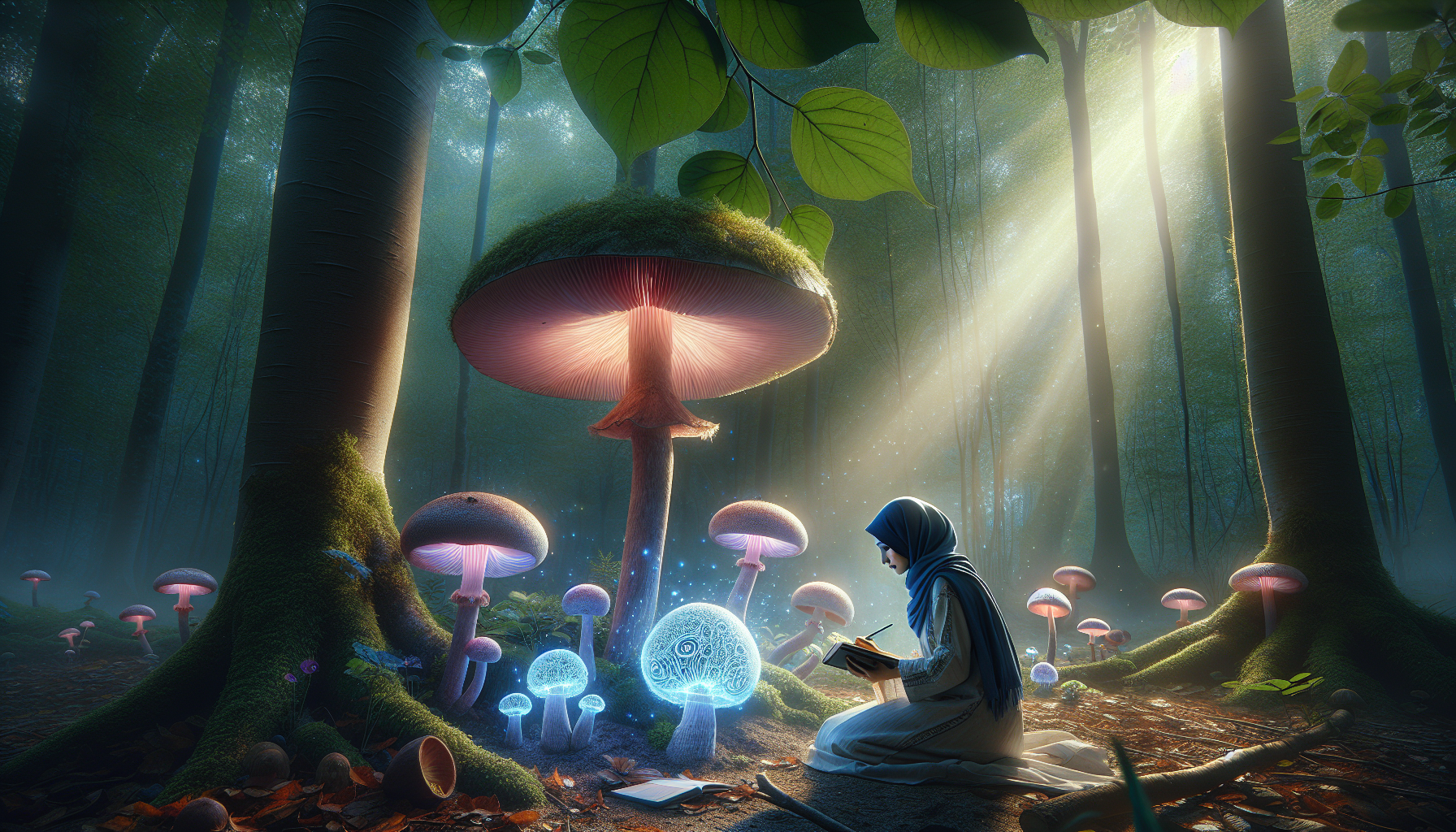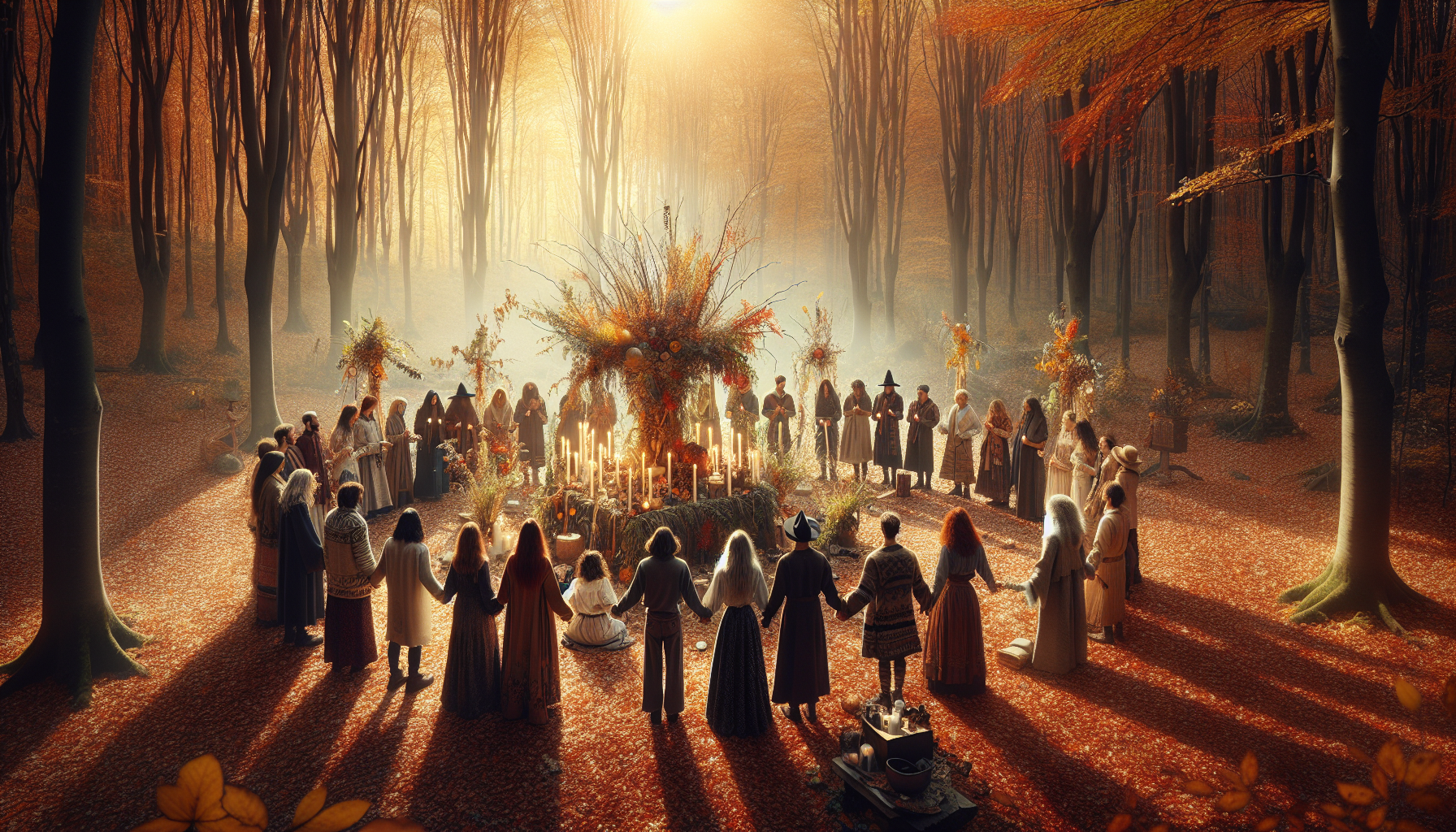In the dimly lit corners of lush forests and the hidden crevices of ancient trees, a silent revolution is taking place—one that bridges the gap between the seen and unseen worlds, weaving an intricate web of life that is as magical as it is mysterious. Welcome to the enchanting realm of fungi, a kingdom that has captivated the human imagination for centuries, sparking curiosity, inspiring folklore, and fueling scientific discovery. In this exploration, we embark on a journey to uncover the secrets of these fascinating organisms, delving into their unique characteristics, their vital ecological roles, and the profound ways in which they communicate with the world around them.
Fungi are far more than mere mushrooms sprouting after a rainstorm; they are nature’s silent communicators, playing a crucial role in sustaining ecosystems across the globe. From the majestic forests of the Amazon to the serene woodlands of Europe, fungi create vast underground networks, often referred to as the “Wood Wide Web,” that connect trees and plants, allowing them to share nutrients and information. This hidden communication network is not only essential for the health of individual trees but also for the resilience of entire ecosystems. Understanding the language of fungi unlocks a world of ecological insights, offering us a new perspective on how interconnected our planet truly is.
But the magic of mushrooms extends far beyond their ecological importance. In recent years, fungi have emerged as a powerhouse of potential in fields ranging from medicine to environmental sustainability. Scientists are harnessing the unique properties of fungi to develop new antibiotics, combat pollution, and even create sustainable building materials. The medicinal potential of fungi, especially the promising research on psychedelic mushrooms, is opening new frontiers in mental health treatment, challenging long-held stigmas and offering hope for conditions such as depression and PTSD. The versatility of fungi continues to inspire innovation, proving that these ancient organisms may hold the key to solving some of our most pressing modern challenges.
As we journey deeper into the world of fungi, we will explore the cultural and historical significance of these enigmatic organisms. Fungi have long been woven into the fabric of human culture, from the sacred rituals of indigenous tribes to the culinary delights of gourmet chefs. They have inspired myths and legends, symbolizing everything from immortality to decay. By examining the rich tapestry of stories and traditions surrounding fungi, we gain insight into how they have shaped—and been shaped by—human civilization. This cultural exploration not only highlights the multifaceted nature of fungi but also underscores their enduring impact on our lives.
Throughout this article, we will delve into the science, history, and cultural significance of fungi, revealing the astonishing ways in which they interact with the world. We will uncover the latest scientific discoveries, explore groundbreaking research, and share stories from those who have dedicated their lives to understanding these remarkable organisms. By the end of our journey, we hope to not only enlighten but also inspire a deeper appreciation for the wonders of the fungal kingdom, encouraging you to see mushrooms not just as curious growths in the forest, but as integral partners in the tapestry of life. 🍄✨
Understanding the Fascinating World of Fungi
The realm of fungi is an enigmatic universe teeming with diversity and potential that far exceeds what many might assume. Often overshadowed by the more visually apparent plant and animal kingdoms, fungi represent a fundamental aspect of life on Earth. These organisms play crucial roles in ecosystems, serve as food and medicine, and are increasingly becoming subjects of scientific inquiry. This article will unravel the layers of the mushroom magic, exploring how conversations with fungi can unlock nature’s secrets.
Fungi are neither plants nor animals. They belong to a kingdom of their own, with more than 100,000 known species and an estimated 5 million still undiscovered. From the common button mushroom found in grocery stores to the mysterious bioluminescent varieties deep in the Amazon rainforest, the diversity is staggering. Fungi can be microscopic, like yeast, or gigantic, such as the Armillaria ostoyae, a honey fungus in Oregon that spans over 2,385 acres and is considered one of the largest living organisms on Earth.
Moreover, the role of fungi in ecosystems is indispensable. They are nature’s recyclers, breaking down organic matter and returning nutrients to the soil. This process not only supports plant life but also stabilizes ecosystems. Fungi also form symbiotic relationships with plants, such as mycorrhizal associations, where they extend the root systems of plants, increasing water and nutrient absorption. This cooperation is vital for plant growth and, subsequently, for the survival of many animal species. 🌱
The Medicinal Properties of Fungi
Fungi have been used in traditional medicine for centuries, long before the advent of modern pharmaceuticals. From the ancient use of Penicillium mold for its antibiotic properties to the recent interest in psilocybin mushrooms for mental health treatment, fungi have proven to be both versatile and potent. The study of fungal compounds is a burgeoning field in biomedical research, uncovering new ways to tackle diseases and improve health.
One of the most well-known medicinal mushrooms is the Reishi, also known as the “mushroom of immortality.” Used in traditional Chinese medicine for over 2,000 years, Reishi is believed to boost the immune system, reduce stress, improve sleep, and enhance overall well-being. Recent studies have confirmed many of these effects, attributing them to compounds like triterpenoids and polysaccharides found in the mushroom.
Another fascinating area of research is the use of psilocybin, the psychoactive compound found in certain mushrooms, for treating mental health disorders. Studies conducted by prestigious institutions such as Johns Hopkins University have demonstrated that psilocybin can have profound effects on patients with depression, anxiety, and PTSD, offering hope for those who do not respond to conventional treatments. As research progresses, the potential of fungi in medicine continues to expand, hinting at a future where these organisms could play a central role in healthcare.
Comparative Table of Medicinal Mushrooms
To better understand the diverse applications of medicinal mushrooms, let’s take a look at the comparative table below.
| Mushroom | Primary Benefits | Active Compounds |
|---|---|---|
| Reishi | Immune support, stress reduction | Triterpenoids, polysaccharides |
| Cordyceps | Energy enhancement, anti-aging | Cordycepin, adenosine |
| Lion’s Mane | Cognitive enhancement, nerve regeneration | Hericenones, erinacines |
Fungi and Sustainable Practices
Beyond their medicinal and ecological roles, fungi also hold promise in the realm of sustainability. As the global population grows and resources become scarcer, finding sustainable alternatives becomes increasingly urgent. Fungi, with their ability to decompose materials and synthesize valuable compounds, are at the forefront of this green revolution.
Mycelium, the root-like network of fungi, is being used to create biodegradable materials that can replace plastics. Companies like Ecovative Design are pioneering this technology, producing packaging, insulation, and even furniture from mycelium. These products are not only eco-friendly but also cost-effective and versatile, showcasing the potential of fungi in reducing environmental impact.
In addition to material science, fungi play a role in sustainable agriculture. Mycoremediation, the use of fungi to decontaminate environments, is gaining traction as a method to cleanse polluted soils and waterways. Certain fungi can break down pollutants such as pesticides and heavy metals, restoring the health of ecosystems. These sustainable practices highlight the potential of fungi as a natural solution to some of the world’s most pressing environmental challenges.
To explore more about fungi’s sustainable potential, watch this insightful video: “The Promise of Fungi in Sustainable Development” – Sustainable Futures Channel.
Interacting with Fungi: Practical Applications and Conversations
As our understanding of fungi deepens, so do the possibilities for interaction and practical application. From foraging wild mushrooms to cultivating gourmet varieties, engaging with fungi can be both rewarding and educational. Foraging, in particular, offers a unique way to connect with nature, teaching individuals about ecosystems and biodiversity while providing delicious and nutritious food.
However, foraging requires knowledge and caution. Many edible mushrooms have toxic look-alikes, making identification crucial. It’s advisable to join guided foraging tours or take classes to learn from experts. Cultivation, on the other hand, is a more controlled way to interact with fungi. With kits and resources readily available, growing mushrooms at home is accessible to anyone, offering fresh produce and the satisfaction of nurturing life.
Conversations with fungi also extend into the realm of education and art. Mycologists and artists are exploring fungi’s intricate forms and vibrant colors, drawing inspiration for scientific study and creative expression. Fungi’s ability to transform and adapt makes them a subject of endless fascination, encouraging us to rethink our relationship with the natural world.
- Learn from expert mycologists through online courses and workshops.
- Explore the culinary potential of mushrooms with gourmet recipes.
- Join local foraging groups to safely discover wild mushrooms.
Fungi’s ability to surprise and delight underscores their magical essence. By unlocking their secrets, we gain insights into the interconnectedness of life and the potential for harmony with nature. As we continue to engage in conversations with fungi, we open doors to a world of possibilities, guided by the wisdom of these ancient organisms.

Conclusion
In conclusion, “Mushroom Magic: Unlocking Nature’s Secrets Through Conversations with Fungi” has taken us on a captivating journey into the world of fungi, exploring their diverse roles and profound impacts on ecosystems, human health, and scientific innovation. Throughout this article, we’ve delved into the intricate relationships that fungi maintain with their environment, their potential in medical advancements, and their role in sustainability and ecological balance.
Firstly, we examined the fundamental roles fungi play in ecosystems as decomposers and symbiotic partners. Their ability to break down complex organic matter is crucial for nutrient cycling, supporting plant growth and maintaining soil health. Moreover, their symbiotic relationships with plants through mycorrhizal associations demonstrate a fascinating form of biological teamwork that enhances plant resilience and productivity.
The article also highlighted the burgeoning field of mycotherapy, where fungi’s medicinal properties are harnessed for health benefits. Compounds derived from mushrooms like Reishi, Lion’s Mane, and Cordyceps are being studied for their potential to boost immune systems, improve cognitive functions, and even combat cancer. These promising findings underscore the necessity of further research and exploration into the therapeutic possibilities fungi offer.
Furthermore, we explored the innovative applications of fungi in sustainability. Mycelium-based materials present eco-friendly alternatives to conventional plastics and building materials, exemplifying the potential of fungi to contribute to a more sustainable future. These materials are biodegradable, reducing environmental impact and aligning with global efforts to mitigate climate change.
The discussions within this article also emphasized the need for conservation and ethical foraging practices. As fungi gain popularity for their myriad uses, it’s imperative to balance utilization with preservation to ensure these vital organisms continue to thrive in their natural habitats.
The importance of fungi extends beyond their ecological and practical applications; they also offer a philosophical perspective on interconnectedness. Fungi remind us of the intricate web of life, where every organism plays a vital role in the ecosystem. This interconnectedness invites us to consider our place within nature and inspires a deeper appreciation for the natural world.
As we close this exploration into the magical world of fungi, it’s important to reflect on the transformative potential they hold for our future. Whether through contributing to sustainable practices, advancing medicine, or enhancing our understanding of ecology, fungi continue to unlock nature’s secrets in ways we are only beginning to comprehend.
We encourage you, our readers, to delve deeper into the world of fungi and explore their potential in your own lives. Whether it’s through supporting sustainable products, experimenting with culinary mushroom dishes, or simply fostering a deeper appreciation for the natural world, there are numerous ways to engage with and benefit from fungi.
Please feel free to share your thoughts and experiences in the comments below. How have fungi impacted your life? What potential do you see in their applications? Sharing your insights not only enriches our community but also helps spread awareness of these incredible organisms.
Additionally, consider sharing this article with friends and family who might be intrigued by the wonders of fungi. By doing so, you contribute to a broader understanding and appreciation of these remarkable organisms and their contributions to our world.
For further exploration into the fascinating realm of fungi, we recommend visiting reputable sources like the Fungal Diversity Survey and Mycological Society of America, which offer extensive information and research on various aspects of mycology.
As we continue to uncover the secrets held within the fungal kingdom, let us remain inspired by their resilience, adaptability, and immense potential to enrich our lives and the planet. Together, we can unlock more of nature’s mysteries and apply this knowledge towards a more sustainable and harmonious future. 🌍🍄
Thank you for joining us on this journey through the enchanting world of fungi.
Gabriel is a visual storyteller and symbolic naturalist whose creations explore the veiled ecologies and ancestral ties between humans and the living world, as echoed through myth and memory. With a sensitivity attuned to the sacred, Gabriel unveils the ancient choreography of plant, animal, and spirit — a realm where forests spoke in signs, rivers kept secrets, and every flower bore a forgotten name.
His path winds through the esoteric — tracing the rituals of forest sages, the herbal codes of ancestral healers, and the silent agreements that once guided human life in deep reciprocity with nature. From moss-covered shrines to twilight groves, Gabriel’s work reveals relationships once vital, now buried beneath layers of modern detachment.
With a foundation in visual design and the aesthetics of ancestral wisdom, Gabriel weaves storytelling into sacred ecology. His work doesn’t just depict — it channels. Drawing from myth, mysticism, and lost herbal traditions, he crafts images and narratives that pulse with the old knowing: that nature is not scenery, but kin and teacher.
Through collections of symbolic visuals, myth-rooted studies, and intuitive reflections, Gabriel invites others to rekindle forgotten senses — to listen not only with ears, but with intuition, memory, and reverence.
His work is a tribute to:
-
The mythic language of trees, stones, and roots
-
Forgotten pacts between healers and the wild
-
The sacred intelligence in nature’s unseen patterns
Whether you walk with the lore of plants, dream with the rhythms of the earth, or simply feel the call of something older in the wind through the leaves, Gabriel welcomes you into a space where symbolism, spirit, and wild nature entwine — one myth, one leaf, one vision at a time.





